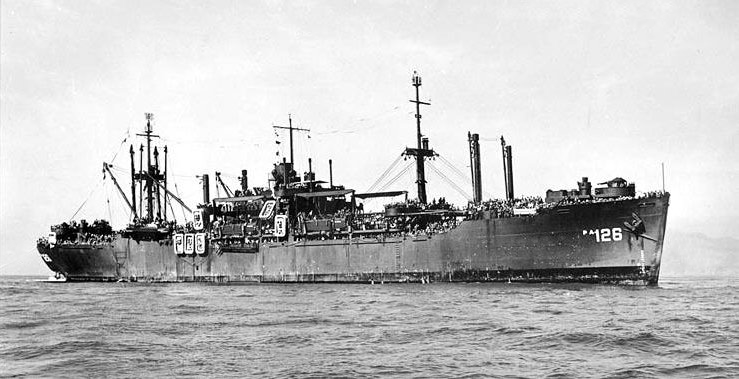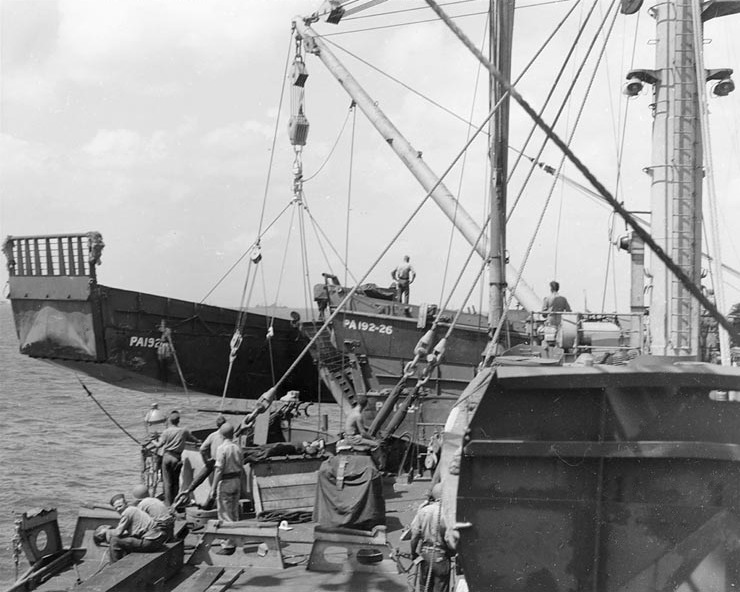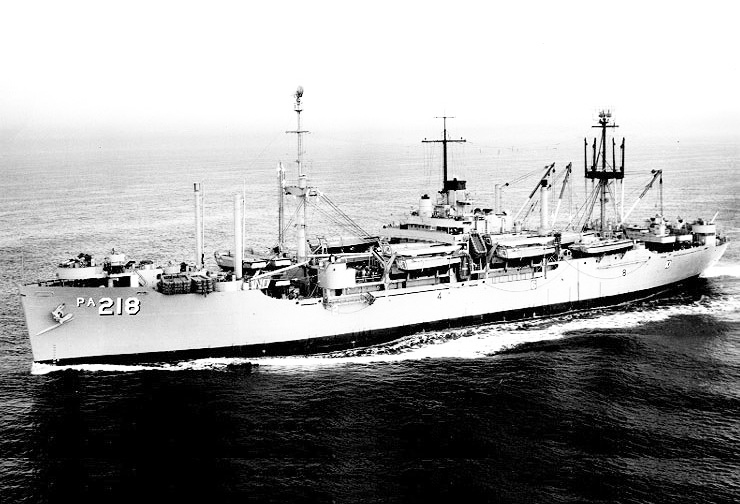

Haskell-class attack transport

Haskell-class attack transports (APA) were amphibious assault ships of the United States Navy created in 1944. They were designed to transport 1,500 troops and their combat equipment, and land them on hostile shores with the ships' integral landing craft.
The Haskells were very active in the World War II Pacific Theater of Operations, landing Marines and Army troops and transporting casualties at Iwo Jima and Okinawa. Ships of the class were among the first Allied ships to enter Tokyo Bay at the end of World War II, landing the first occupation troops at Yokosuka. After the end of World War II, most participated in Operation Magic Carpet, the massive sealift of US personnel back to the United States. A few of the Haskell class were reactivated for the Korean War, with some staying in service into the Vietnam War.
The Haskell class, Maritime Commission standard type VC2-S-AP5, is a sub‑type of the World War II Victory ship design. 117 were launched in 1944 and 1945, with 14 more being finished as another VC2 type or canceled. Built by the War Shipping Administration under the Emergency Shipbuilding program.
Design
The VC2-S-AP5 design was intended for the transport and assault landing of over 1,500 troops and their heavy combat equipment. During Operation Magic Carpet, up to 1,900 personnel per ship were carried homeward.
The Haskells carried 25 landing craft to deliver the troops and equipment right onto the beach. The 23 main boats were the 36-foot (11 m)-long LCVP. The LCVP was designed to carry 36 equipped troops. The other two landing craft were the 50-foot (15 m)-long LCM (3), capable of carrying 60 troops or 30 tons (27 t) of cargo, or the 56-foot (17 m) LCM (6). They also carried one gig.
The Haskell-class ships were armed with one 5"/38 caliber gun, twelve Bofors 40 mm guns (one quad mount, four dual mounts), and ten Oerlikon 20 mm guns.
History
Haskell-class attack transports included APA-117, USS Haskell, the lead ship, through APA-247, the never completed USS Mecklenburg. The hulls for APA-181 through APA-186 were repurposed to be hospital ships before they were named. Ultimately those hospital ships were built on larger C4 plan and the six VC2 hulls were built in a merchant configuration. APA-240 through APA-247 were named, but cancelled in 1945 when the war ended. With the special exception of USS Marvin H. McIntyre, the Haskell-class ships were all named after counties of the United States
Service
Most of the Haskell-class ships were mothballed in 1946, with only a few remaining in service. Many of the Haskell class were scrapped in 1973–75. A few were converted into Missile Range Instrumentation Ships.
USS Gage, the last remaining ship in the Haskell configuration, was scrapped in 2009 at ESCO Marine, in Brownsville, Tx.[4]
USS Sherburne, which was converted and renamed USS Range Sentinel, lasted until she was scrapped in 2012.
Source: Wikipedia

USS St. Mary's in San Francisco Bay, California, in late 1945 or early 1946. She is returning troops from the western Pacific to the United States as part of Operation Magic Carpet. Note the long homeward bound pennant trailing from her after mast, and the sign on shore (in the right distance) stating "Welcome Home, Well Done."

USS Rutland lowering an LCM off Iwo Jima in 1945

USS Noble, a ship of the Haskell class, in 1956
Name:
Builders:
Operator:
Proceeded by:
Built:
In commission:
Planned:
Completed:
Cancelled:
Haskell class
California Shipbuilding
Oregon Shipbuilding
Permanente Metals
Kaiser Shipbuilding
United States Navy
Gilliam class
1944-1945
11 September 1944 – 29 October 1945
131
117
14
Class and type:
Displacement:
Length:
Beam:
Draft:
Propulsion:
Speed:
Boats & landing
craft carried:
Capacity:
Complement:
Armament:
Notes:
Haskell class attack transport
6,873 tons (lt), 14,837 t (fl)
455 ft (139 m)
62 ft (19 m)
24 ft (7 m)
1 × geared turbine (Westinghouse, Joshua Hendy or Allis-Chalmers), 2 × header-type boilers (Babcock & Wilcox or Combustion Engineering), 1 × propeller, designed 8,500 shp (6,338 kW)
18–19 knots (33–35 km/h; 21–22 mph)
2 × LCM
12 × LCVP
3 × LCPL
Troops: 86 officers, 1,475 enlisted
Cargo: 150,000 cu ft, 2,900 tons
56 officers, 480 enlisted
1 × 5"/38 dual-purpose gun
4 × twin 40mm guns
10 × single 20mm guns
late armament, add 1 × 40mm quad mount
MCV hull type: VC2-S-AP5
Completed
Allendale
Arenac
Attala
Audubon
Bandera
Barnwell
Beckham
Bergen
Bexar
Bingham
Bland
Bollinger
Bosque
Botetourt
Bottineau
Bowie
Braxton
Broadwater
Bronx
Brookings
Buckingham
Clearfield
Clermont
Clinton
Colbert
Collingsworth
Cottle
Crockett
Dane
Darke
Deuel
Dickens
Drew
Eastland
Edgecombe
Effingham
Fond du Lac
Freestone
Gage
Gallatin
Glynn
Gosper
Granville
Grimes
Haskell
Hendry
Highlands
Hinsdale
Hocking
Hyde
Jerauld
Karnes
Kenton
Kershaw
Kingsbury
Kittson
La Grange
La Porte
Lander
Lanier
Latimer
Lauderdale
Laurens
Lavaca
Lenawee
Logan
Lowndes
Lubbock
Lycoming
Magoffin
Marathon
Marvin H. McIntyre
McCracken
Mellette
Menard
Menifee
Meriwether
Mifflin
Missoula
Montrose
Mountrail
Napa
Natrona
Navarro
Neshoba
New Kent
Newberry
Noble
Oconto
Okaloosa
Okanogan
Olmstead
Oneida
Oxford
Pickaway
Pickens
Pitt
Pondera
Randall
Range
Rawlins
Renville
Rockbridge
Rockingham
Rockwall
Rutland
Saint Croix
San Saba
Sanborn
Sandoval
Sarasota
Sentinel
Sevier
Sherburne
Sibley
St. Mary's
Talladega
Tazewell
Telfair
Cancelled
Harnett
Hempstead
Iredell
Luzerne
Medera
Maricopa
McLennan
Mecklenburg


